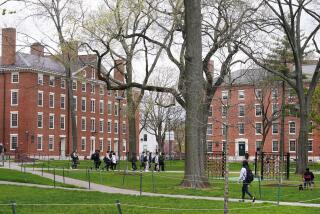Aid for Low-Income Students Lags
- Share via
WASHINGTON — Low-income students who are qualified academically for college may soon be shut out of the hallowed halls anyway because of a financial aid system that favors middle-class students, according to a panel authorized by Congress to oversee financial aid.
The issue starts with a rising number of low-income students qualifying for college.
“We’ve all heard about the baby boom, but now we have a baby boom echo, which rivals the baby boom in size,” said Juliet V. Garcia, president of the University of Texas at Brownsville and a member of the Advisory Committee on Student Financial Assistance.
Combine that boom with escalating costs, inadequate grants and a shift by colleges away from need-based aid programs that generally help students lacking financial resources, and the result could be a barrier keeping qualified students out of college, the committee said Wednesday.
According to the report, many of the nation’s poorest students kept pace with their peers in preparing for college.
From 1987 to 1999, completion rates on college preparatory courses grew more than 20% for the poorest students, while middle-class students’ completion rates grew about 21%.
Given current demographic projections, by 2015, an ethnically and economically diverse group of students--80% of them minority--will apply for college.
More than 45% of minority students will be from families that can contribute only a minimum amount and must rely on generous financial aid.
But since 1993, the report said, state-funded, merit-based financial aid programs, which favor middle-class students, have increased 336% in real dollars. Meanwhile, funding for need-based financial aid programs, which favor poorer students, has risen 88%.
The report said rising college costs also are hitting poor families harder, with more of their income eaten up by college expenses.
Last year, the cost of college as a percentage of real family income was 62% for low-income families, 16% for middle-class families, and 7% for the wealthiest.
Even after they get to college, the report said, low-income students end up footing a larger proportion of the bill than other students. After subtracting grants, loans and personal outlays, low-income students in a four-year public college typically face $3,800 in college-related debt.
Middle class students typically face $2,250 in unmet need, while upper-income students face $400 in debt.
At the same time, the report said, the maximum federal Pell grant has failed to keep pace with college costs. In 1975, a student could cover 84% of costs at a public four-year college with such grants. By last year, he or she could only cover 39%.
As a result, many low-income students are forced to work full- or part-time, cut back on course work or simply drop out.
The committee said federal and state governments must shift to awarding financial aid more on the basis of need.
Education Secretary Rod Paige on Tuesday said President Bush wants to increase the maximum Pell grant by more than 50%, to $5,100, for first-year students. Currently, the maximum is $3,300.
Garcia applauded the proposal, saying the committee wants to go further--she urged Bush to double the maximum Pell grant to $6,600.
Jeff Stoltman, who oversees financial aid at Wayne State University in Detroit, said doubling Pell grants is a strictly short-term solution.
“It’s a big Band-Aid, but it’s a Band-Aid,” he said.
Stoltman said one recommendation of the report is right on target: Colleges, states and the federal government must work together to help keep low-income students afloat.
More to Read
Sign up for Essential California
The most important California stories and recommendations in your inbox every morning.
You may occasionally receive promotional content from the Los Angeles Times.













